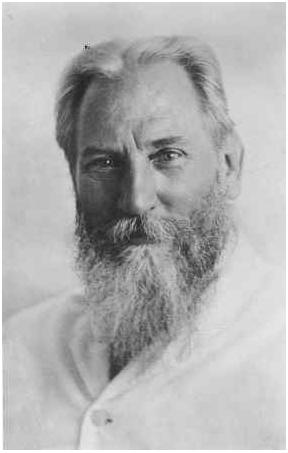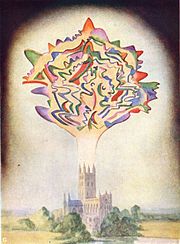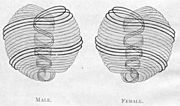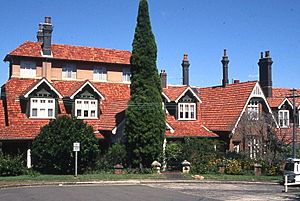Charles Webster Leadbeater facts for kids
Quick facts for kids
Charles Webster Leadbeater
|
|
|---|---|

Leadbeater in 1914 (age 60)
|
|
| Born | 16 February 1854 |
| Died | 1 March 1934 (aged 80) Perth, Australia
|
| Known for | Theosophist and writer |
Charles Webster Leadbeater (/ˈlɛdˌbɛtər/; 16 February 1854 – 1 March 1934) was a member of the Theosophical Society, Co-Freemasonry, an author on occult subjects, and the co-initiator, with J. I. Wedgwood, of the Liberal Catholic Church.
Originally a priest of the Church of England, his interest in spiritualism caused him to end his affiliation with Anglicanism in favour of the Theosophical Society, where he became an associate of Annie Besant. He became a high-ranking officer of the Society and remained one of its leading members until his death in 1934, writing over 60 books and pamphlets and maintaining regular speaking engagements.
Contents
- Early life
- Theosophical Society
- Headmaster in Ceylon
- Return to England
- Meeting with Annie Besant
- Writing and speaking career
- Resignation from the Theosophical Society
- Readmission to the Theosophical Society
- Discovery of Krishnamurti
- Australia and The Science of the Sacraments
- Legacy
- Selected writings
- See also
Early life
Leadbeater was born in Stockport, Cheshire, in 1854. His father, Charles, was born in Lincoln and his mother Emma was born in Liverpool. He was an only child. By 1861, the family had relocated to London, where his father was a railway contractor's clerk.
In 1862, when Leadbeater was eight years old, his father died from tuberculosis. Four years later a bank in which the family's savings were invested became bankrupt. Without finances for college, Leadbeater sought work soon after graduating from high school in order to provide for his mother and himself. He worked at various clerical jobs. During the evenings he became largely self-educated. For example, he studied astronomy and had a 12-inch reflector telescope (which was very expensive at the time) to observe the heavens at night. He also studied French, Latin and Greek.
An uncle, his father's brother-in-law, was the well-known Anglican cleric William Wolfe Capes. By his uncle's influence, Leadbeater was ordained an Anglican priest in 1879 in Farnham by the Bishop of Winchester. By 1881, he was living with his widowed mother at Bramshott in a cottage which his uncle had built, where he is listed as "Curate of Bramshott". He was an active priest and teacher who was remembered later as "a bright and cheerful and kindhearted man". About this time, after reading about the séances of reputed medium Daniel Dunglas Home (1833–1886), Leadbeater developed an active interest in spiritualism.
Theosophical Society
His interest in Theosophy was stimulated by A.P. Sinnett's Occult World, and he joined the Theosophical Society in 1883. The next year he met Helena Petrovna Blavatsky when she came to London; she accepted him as a pupil and he became a vegetarian.
Around this time he wrote a letter to Kuthumi, asking to be accepted as his pupil. Shortly afterward, an encouraging response influenced him to go to India; he arrived at Adyar in 1884. He wrote that while in India, he had received visits and training from some of the "Masters" that according to Blavatsky were the inspiration behind the formation of the Theosophical Society, and were its hidden guides. This was the start of a long career with the Theosophical Society.
Headmaster in Ceylon
During 1885, Leadbeater traveled with Henry Steel Olcott (1832–1907), first President of the Theosophical Society, to Burma and Ceylon (now Sri Lanka). In Ceylon they founded the English Buddhist Academy, with Leadbeater staying there to serve as its first headmaster under very austere conditions. This school gradually expanded to become Ananda College, which now has more than 6,000 students and has a building named for Leadbeater. After Blavatsky left Adyar in 1886 to return to Europe and finish writing The Secret Doctrine, Leadbeater claimed to have developed clairvoyant abilities.
Return to England
In 1889, Sinnett asked Leadbeater to return to England to tutor his son and George Arundale (1878–1945). He agreed and brought with him one of his pupils, Curuppumullage Jinarajadasa (1875–1953). Although struggling with poverty himself, Leadbeater managed to send both Arundale and Jinarajadasa to Cambridge University. Both would eventually serve as International presidents of the Theosophical Society.
Meeting with Annie Besant
After H. P. Blavatsky's death in 1891, Annie Besant, an English social activist, took over leadership of the Theosophical Society along with Colonel Olcott. Besant met Leadbeater in 1894. The next year she invited him to live at the London Theosophical Headquarters, where H.P. Blavatsky died in 1891.
Writing and speaking career
Leadbeater wrote over 60 books and pamphlets during the period from 1895 to his death in 1934, many of which continued to be published until 1955. Two noteworthy titles, Astral Plane and the Devachanic Plane (or The Heaven World) both of which contained writings on the realms the soul passes through after death.
"For the first time among occultists, a detailed investigation had been made of the Astral Plane as a whole, in a manner similar to that in which a botanist in an Amazonian jungle would set to work in order to classify its trees, plants and shrubs, and so write a botanical history of the jungle. For this reason the little book, The Astral Plane, was definitely a landmark, and the Master as Keeper of the Records desired to place its manuscript in the great Museum."
Highlights of his writing career included addressing topics such as: the existence of a loving God, The Masters of Wisdom, what happens after death, immortality of the human soul, reincarnation, Karma or the Law of Consequence, development of clairvoyant abilities, the nature of thought forms, dreams, vegetarianism, Esoteric Christianity
He also became one of the best known speakers of the Theosophical Society for a number of years and served as Secretary of the London Lodge.
Clairvoyance

Clairvoyance is a book by Leadbeater originally published in 1899 in London. It is a study of a belief in seeing beyond the realms of ordinary sight. The author mainly appeals readers "convinced of the existence of clairvoyance and familiar with theosophical terms." Leadbeater claims that the "power to see what is hidden from ordinary physical sight" is an extension of common reception, and "describes a wide range of phenomena."
Methods of development
Leadbeater writes about the importance of control over thinking and the need for skill "to concentrate thought":
"Let a man choose a certain time every day—a time when he can rely upon being quiet and undisturbed, though preferably in the daytime rather than at night—and set himself at that time to keep his mind for a few minutes entirely free from all earthly thoughts of any kind whatever and, when that is achieved, to direct the whole force of his being towards the highest spiritual ideal that he happens to know. He will find that to gain such perfect control of thought is enormously more difficult than he supposes, but when he attains it, it cannot but be in every way most beneficial to him, and as he grows more and more able to elevate and concentrate his thought, he may gradually find that new worlds are opening before his sight."
Author's personal experience
Professor Robert Ellwood wrote that from 1884 to 1888 Leadbeater undertook a course of meditation practice "which awakened his clairvoyance." One day when the Master Kuthumi visited, he asked whether Leadbeater had ever attempted "a certain kind of meditation connected with the development of the mysterious power called kundalini." The Master recommended him to make a "few efforts along certain lines," and told him that he would himself "watch over those efforts to see that no danger should ensue." Leadbeater accepted the offer of the Master and became "day after day" working on this kind of meditation. He worked on the task assigned to him for forty-two days, and it seemed to him that he was already on the verge of achieving a result when Kuthumi intervened and "performed the final act of breaking through which completed the process," and enabled Leadbeater thereafter to use astral sight while as he was retaining full consciousness in the physical body. It is equivalent to saying that "the astral consciousness and memory became continuous," whether the physical body was awake or asleep.
Possible application
In the chapter "Simple Clairvoyance: Full" the author argues that an occultist-clairvoyant can "see" the smallest particles of matter, for example, a molecule or atom, magnifying them "as though by a microscope." In the chapter "Clairvoyance in Time: The Past" Leadbeater claims that before the historian who is in "full possession of this power" open up wonderful possibilities:
"He has before him a field of historical research of most entrancing interest. Not only can he review at his leisure all history with which we are acquainted, correcting as he examines it the many errors and misconceptions which have crept into the accounts handed down to us; he can also range at will over the whole story of the world from its very beginning."
New editions and translations
The book was reprinted several times and translated into some European languages. Second edition of the book was published in 1903, and third—in 1908.
Resignation from the Theosophical Society
In 1906, several members of the Theosophical Society to ask for his resignation on charges of miscounduct. After a biased trial, he resigned.
Readmission to the Theosophical Society
After Olcott died in 1907, Annie Besant became president of the society following a political struggle. By the end of 1908, the International Sections voted for Leadbeater's readmission. He accepted and came to Adyar on 10 February 1909. At the time, Besant referred to Leadbeater as a martyr who was wronged by her and by the Theosophical Society, saying that "never again would a shadow come between her and her brother Initiate".
Discovery of Krishnamurti
In 1909 Leadbeater encountered fourteen-year-old Jiddu Krishnamurti at the private beach of the Theosophical Society headquarters at Adyar. Krishnamurti's family lived next to the compound; his father, a long-time Theosophist, was employed by the Society. Leadbeater believed Krishnamurti to be a suitable candidate for the "vehicle" of the World Teacher, a reputed messianic entity whose imminent appearance he and many Theosophists were expecting. The proclaimed savior would then usher in a new age and religion.
Leadbeater assigned the pseudonym Alcyone to Krishnamurti and under the title "Rents in the Veil of Time", he published 30 reputed past lives of Alcyone in a series in The Theosophist magazine beginning in April 1910. "They ranged from 22,662 BC to 624 AD ... Alcyone was a female in eleven of them."
Leadbeater stayed in India until 1915, overseeing the education of Krishnamurti; he then relocated to Australia. During the late 1920s, Krishnamurti disavowed the role that Leadbeater and other Theosophists expected him to fulfil. He disassociated himself from the Theosophical Society and its doctrines and practices, and during the next six decades became known as an influential speaker on philosophical and religious subjects.
Australia and The Science of the Sacraments
Leadbeater moved to Sydney in 1915. He was responsible for the construction of the Star Amphitheatre at Balmoral Beach in 1924. While in Australia he became acquainted with J. I. Wedgwood, a Theosophist and bishop in the Liberal Catholic Church who initiated him into Co-Masonry in 1915 and later consecrated him as a bishop of the Liberal Catholic Church in 1916.
Public interest in Theosophy in Australia and New Zealand increased greatly as a result of Leadbeater's presence there and Sydney became comparable to Adyar as a centre of Theosophical activity.
In 1922, the Theosophical Society began renting a mansion known as The Manor in the Sydney suburb of Mosman. Leadbeater took up residence there as the director of a community of Theosophists. The Manor became a major site and was regarded as "the greatest of occult forcing houses". There he accepted young women students. They included Clara Codd, future President of the Theosophical Society in America, clairvoyant Dora van Gelder, another future President of the Theosophical Society in America who during the 1970s also worked with Delores Krieger to develop the technique of Therapeutic touch, and Mary Lutyens, who would later write an authorized Krishnamurti biography. Lutyens stayed there in 1925, while Krishnamurti and his brother Nitya stayed at another house nearby. The Manor became one of three major Theosophical Society sites, the others being at Adyar and the Netherlands. The Theosophical Society bought The Manor in 1925 and during 1951 created The Manor Foundation Ltd, to own and administer the house, which is still used by the Society.
It was also during his stay in Australia that Leadbeater became the Presiding Bishop of the Liberal Catholic Church and co-wrote the liturgy book for the church which is still in use today. The work represents an adaptation of the Roman Catholic liturgy of his time, for which Leadbeater sought to remove what he regarded as undesirable elements, such as (in his view) the blatant anthropomorphisms and expressions of the fear and wrath of God, which he regarded "as derogatory alike to the idea of a loving Father and to the men He has created in His own image."
"If Christians", he wrote, "had been content to take what Christ taught of the Father in heaven, they would never have saddled themselves with the jealous, angry, bloodthirsty Jehovah of Ezra, Nehemiah and the others – a god that needs propitiating and to whose 'mercy' constant appeals must be made."
Thus the Credo of the Liberal Catholic Church liturgy written by Leadbeater reads:
- "We believe that God is Love and Power and Truth and Light; that perfect justice rules the world; that all His sons shall one day reach His Feet, however far they stray. We hold the Fatherhood of God, the Brotherhood of man; we know that we do serve Him best when best we serve our brother man. So shall His blessing rest upon us and peace for evermore. Amen."
Previously, Leadbeater had written on the energies of the Christian sacraments in The Science of the Sacraments: An Occult and Clairvoyant Study of the Christian Eucharist, one of the most significant works of Christian esotericism. In his prologue to the latest edition of this book, John Kersey refers to the Eucharist proposed by Leadbeater as "a radical reinterpretation of the context of the Eucharist seen within a theological standpoint of esoteric magic and universal salvation; it is Catholicism expressing the love of God to the full without the burdens of needless guilt and fear, and the false totem of the temporal powers of the church."
Legacy
Leadbeater remains well-known and influential in New Age circles for his many works based on his clairvoyant investigations of life, including such books as Outline of Theosophy, Astral Plane, Devachanic Plane, The Chakras and Man, Visible and Invisible dealing with, respectively, the basic principles of theosophy, the two higher worlds humanity passes through after "death", the chakra system, and the human aura.
His writings on the sacraments and Christian esotericism remain popular, with a constant stream of new editions and translations of his magnum opus The Science of the Sacraments. His liturgy book is still used by some Liberal and Independent Catholic Churches.
Selected writings
- Dreams (What they are and how they are caused) (1893)
- Theosophical Manual Nº5: The Astral Plane (Its Scenery, Inhabitants and Phenomena) (1896)
- Theosophical Manual Nº6: The Devachanic Plane or The Heaven World Its Characteristics and Inhabitants (1896)
- Invisible Helpers (1896)
- Reincarnation (1898)
- Our Relation to Our Children (1898)
- Clairvoyance (1899)
- An Outline of Theosophy (1902)
- Man Visible and Invisible (1902)
- Some Glimpses of Occultism, Ancient and Modern (1903)
- The Christian Creed (1904)
- Thought Forms (with Annie Besant) (1905)
- Occult Chemistry (with Annie Besant) (1908)
- The Inner Life (1911)
- The Perfume of Egypt and Other Weird Stories (1911)
- The Power and Use of Thought (1911)
- The Life After Death and How Theosophy Unveils It (1912)
- A Textbook of Theosophy (1912)
- Man: Whence, How and Whither (with Annie Besant) (1913)
- Vegetarianism and Occultism (1913)
- The Hidden Side of Things (1913)
- Australia & New Zealand: Home of a new sub-race (1916)
- The Monad and Other Essays Upon the Higher Consciousness (1920)
- The Inner Side of Christian Festivals (1920)
- The Science of the Sacraments (1920)
- The Lives of Alcyone (with Annie Besant) (1924)
- The Liturgy According to the Use of the Liberal Catholic Church (with J.I. Wedgwood) (Second Edition) (1924)
- The Masters and the Path (1925)
- Talks on the Path of Occultism (1926)
- Glimpses of Masonic History (1926) (later pub 1986 as Ancient Mystic Rites)
- The Hidden Life in Freemasonry (1926)
- The Chakras (1927) (published by the Theosophical Publishing House, Wheaton, Illinois, USA)
- Spiritualism and Theosophy Scientifically Examined and Carefully Described (1928)
- The Noble Eightfold Path (1955)
- Messages from the Unseen (1931)
See also
- Chakras
- Clairvoyance
- Christian mythology
- K.H. Letters to C.W. Leadbeater
- Reincarnation
- Root race
- Theosophy and Christianity
- Theosophy and visual arts



